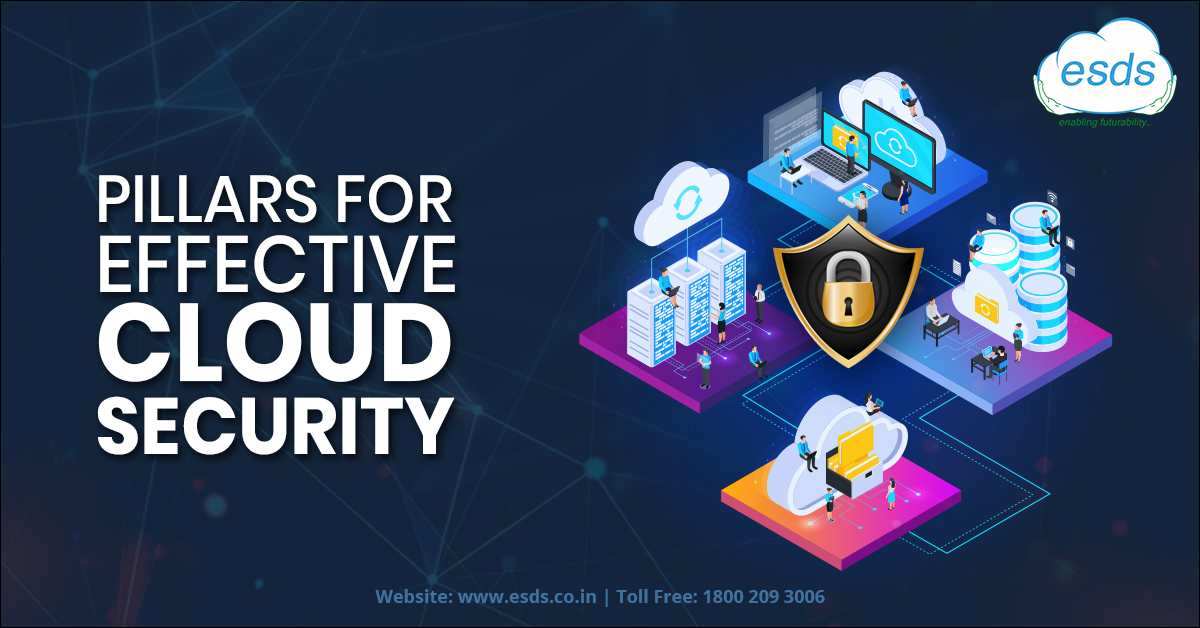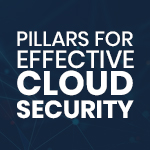PILLARS FOR EFFECTIVE CLOUD SECURITY
Businesses today operate a massive volume of sensitive data and also perform various operations with this data. Data breaches are getting too familiar in today’s time. A successful operation in the cloud demands for diversified mechanisms and procedures compared to an on-premise cloud computing solution. An online analysis done by the Gartner states that- by 2020, 80% of the cloud breaches will be caused due to customer misconfigurations, wrongly-managed credentials, or even insider thefts. However, cloud breaches will not be a result of the cloud provider’s vulnerabilities.

Operating in a secured cloud-based solution demands for different mechanisms and ways as compared to an on-premise deployment. An on-premise cloud solution, however, will not work effectively in the cloud. Also, the cloud-based infrastructures house several security services that are to be included.
Cloud Security Pillars
A successfully performed migration to any cloud security framework is dependent on the pillars that follow a sequential cycle. In this sequential cycle, every pillar is dependent on the pillar, just preceding it. Any business organization that follows this methodology is successfully able to create a framework that can support cloud strategies as well as optimize the complete security of the cloud.
So, the following are the pillars that determine effective cloud security
Pillar #1: Identity Access Management
In most of the cases, customers perceive identity access management or IAM from the users, roles, and permissions angle. In a cloud-based infrastructure, IAM enables the IT admins in the organization to authorize the persons who are going to perform actions for specific resources. Additionally, IAM also allows the IT admins to give complete transparency and control at all levels of cloud infrastructure.
On the same lines, companies hosted in the cloud need to understand that services can be a similar part to the same IAM as its users and also, these services have to be recognized on the grounds of how they are accessed and managed.
To leverage the significance of this IAM pillar, companies must compulsorily allow single sign-on (SSO), multi-factor authentication, provider roles-based access controls, and minimize the opportunities for the privileged user accounts.
Pillar #2: Network Security
Most of the organizations fail to initiate the framework of cloud security built around network security. However, this network security is entirely different from Cloud Security. In this security model, it is a shared responsibility model beneath which the cloud ecosystems operate and guarantees the network security, providing no assurance about the safety of the companies that access it.
With the introduction of firewalls and WAFs comes handy for the cloud by offering security at different stages. The functionalities provided by the WAFs are designed to operate in a complete off-premise setup. Since these resources are more of cloud-based, there is an always increased demand to set the benchmark and standard policies like CIS, that describe the cloud-oriented policies for identifying and violations in security policy. Such policy violations relatively don’t occur with an on-premise cloud infrastructure.
Lastly, this network security pillar also needs to consider the significance of endpoint security inevitably. Companies must understand that the benchmarked policies and standards are meant for their businesses only and deploy their solutions that convert these defined benchmarks into provable outcomes.
Pillar #3: Protection of Data
The obvious notions of data present in the in-motion and rest stage tend to become very foggy in a cloud environment. The data present in the transit state is more vulnerable and exposed to different kinds of malicious activities, making it difficult to protect such data.
The protection of data can be done through the means of encryption, which also happens to be the most common method for protecting the data present in the transit and rest stage. However, encryption mechanisms don’t depict a complete solution. Network solution-based controls also add an additional protection layer. Data identified as at-risk stages can have specific policies applied at the time of its access or movement.
Also, there are other considerations in the data that are to be taken into account (archiving and continuous scanning of threats). To understand this, consider the example of emails that are present in the spam/junk/trash folder often has hidden risks that might be triggered if they’re opened later. Thus, to ensure maximum protection of user data, they must be mandatorily removed from the user’s system periodically. Companies these days for total visibility of their data & information along with its end-to-end protection and encryption, this makes the protection of data inevitably and indispensably important.
Pillar #4: Incident Response
Some organizations perceive incident response (IR) as the first physical symptom for a non-actionable and visible Cloud security framework. With cybersecurity attacks consistently rising, some of these cyber incidents are not even easily identified at the early stages, with the due damage already been done.
When an actionable IR framework is considered, all the incidents taking place are seen as security failures or lack of compliance-based issues. The lack of compliance issues can be easily determined at the early stages of an incident taking place and rectified, with the underlying motive to respond to such incidents even before they strike.
In any organization, IR can take place through various methods ranging from simpler identification and correction to altering the policies and strategies for avoiding further such incidents. Businesses must encash on an actionable cloud-based framework as the foundation for enforcing security.
Wrapping Up:
Once the business organization has identified the pillars of Cloud security and come up with a strategy for filling any gaps, they need to deploy & leverage the services of a trusted managed security provider. A managed security provider helps in implementing various tools and processes for allowing an actionable Cloud security framework to take place. The managed security also ensures that these frameworks don’t hinder the Cloud migration processes and remain an indispensable component of the complete security framework for an organization.
- Considering Data Centers in India to Overcome Economic Conditions - May 10, 2022
- Determining Why Your Organization Needs Web Application Security - February 11, 2022
- How Does a Business Benefit with Managed Services - January 21, 2022
